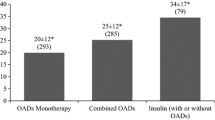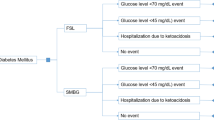Summary
In a prospective controlled trial the effects of a 5-day in-patient treatment and teaching programme for Type 1 (insulin-dependent) diabetes mellitus on metabolic control and health care costs were studied in Moscow. Two different intervention programmes were compared, one based upon urine glucose self-monitoring (UGSM, n = 61) and one using blood glucose selfmonitoring (BGSM, n = 60). Follow-up was 2 years. A control group (n = 60) continued the standard treatment of the Moscow diabetes centre and was followedup for 1 year. Costs and benefits with respect to hospitalizations and lost productivity (according to average wage) were measured in November 1992 roubles (Rb.), with respect to imported drugs and test strips in 1992 German marks (DM). In the intervention groups there were significant decreases of HbA1 values [UGSM: 12.5% before, 9.4% after 1 year, 9.2% after 2 years (p < 0.0001); BGSM: 12.6% before, 9.3% after 1 year, 9.2 % after 2 years (p < 0.0001) compared to no change in the control group (12.2% before, 12,3% after 1 year)], and of the frequency of ketoacidosis. The frequency of severe hypoglycaemia was comparable between the UGSM (10 cases during 2 years), BGSM (10 cases during 2 years), and the control group (8 cases during 1 year). In the combined intervention groups, there were significant decreases of hospital days per patient per year (12.1 during the year before, 1.0 year one after, 3.6 year two after, p < 0.005), and of additional sick leave days (16.6 during the year before, 2.4 year one, 7.8 year two after, p < 0.01), whereas these parameters remained unchanged in the control group. The initial costs of the intervention were outweighed by this subsequent reduction in hospitalizations and lost productivity. Net savings totalled up to 14400 Rb./patient within 2 years. Patients of the intervention groups were told to discontinue drugs which were not indicated and/or ineffective (clofibrate, pentoxifylline, calcium dobesilate). This caused estimated average savings of DM 240 per patient per year. Costs of test strips for UGSM were DM 180 per patient per year; for BGSM they were estimated to lie between DM 370 and DM 550 per patient per year, depending on the frequency of measurements. In conclusion, the intervention led to an improvement of metabolic control and saved resources for health care by reducing hospitalizations and sick leave days. When UGSM is used, costs of test strips are approximately outweighed by discontinuing ineffective drugs.
Similar content being viewed by others
References
Diabetes care and research in Europe. The Saint Vincent Declaration action programme (1992) G Ital Diabet 12 [Suppl 2]: 1–56
Starostina E, Antsiferov M, Bott U, Grüßer M, Jörgens V, Galstyan G (1991) Häufigkeit der diabetischen Retinopathie bei Typ-1-Diabetikern in Moskau und in der Bundesrepublik Deutschland. Akt Endokr Stoffw 12: 286 (Abstract)
Potyomkin VV (1986) Diabetes mellitus. In: Textbook on endocrinology for medical students. Meditsina, Moscow pp 215–310 (In Russian)
Gallus AS, Gleadow F, Dupont et al. (1985) Intermittent claudication: a double blind cross-over trial of pentoxifylline. Aust NZ J Med 15: 402–408
Larsen HW, Sander E, Hoppe R (1977) The value of calcium dobesilate in the treatment of diabetic retinopathy. A controlled clinical trial. Diabetologia 13: 105–109
Stamper RL, Smith ME, Aronson SB et al. (1978) The effect of calcium dobesilate on non-proliferative diabetic retinopathy: a controlled trial. Ophthalmology 85: 594–607
Starostina E, Antsiferov M (1990) Diabetes education in the USSR: how to begin? Diabetic Med 7: 744–749
Assal JP, Mühlhauser I, Pernet A, Gfeller R, Jörgens V, Berger M (1985) Patient education as the basis for diabetes care in clinical practice and research. Diabetologia 28: 602–613
Mühlhauser I, Bruckner I, Berger M et al. (1987) Evaluation of an intensified insulin treatment and teaching programme as routine management of type 1 (insulin-dependent) diabetes —the Bucharest-Düsseldorf Study. Diabetologia 30: 681–690
Jörgens V, Grüßer M, Bott U, Mühlhauser I, Berger M (1993) Effective and safe translation of intensified insulin therapy to general internal medicine departments. Diabetologia 36: 99–105
Kaplan RM, Davis WK (1986) Evaluating the costs and benefits of outpatient diabetes education and nutrition counseling. Diabetes Care 9: 81–86
Meeting on national and regional implementation of the St Vincent Declaration targets. A report from the programme on quality of care and technologies (1992). WHO, Regional Office for Europe, Copenhagen, Denmark; EUR/ICP/CLR 055
Glasgow RE, Osteen VL (1992) Evaluating diabetes education. Diabetes Care 15: 1423–1432
de Weerdt I, Visser AP, Kok GJ, de Weerdt O, van der Veen EA (1991) Randomized controlled multicentre evaluation of an education programme for insulin-treated diabetic patients: effects on metabolic control, quality of life, and costs of therapy. Diabetic Med 8: 338–345
Galstyan GR (1993) Evaluation of the efficacy of a teaching and treatment programme for type 1 diabetic patients: clinical, metabolic and medico-social parameters. Thesis. National Research Centre for Endocrinology, Moscow (In Russian)
Drummond M, Stoddart GL, Torrance GW (1987) Methods for the economic evaluation of health care programmes. Oxford University Press, Oxford, pp 18–38
Guyatt G, Drummond M, Feeny D et al. (1986) Guidelines for the clinical and economic evaluation of health care technologies. Soc Sci Med 22: 393–408
Drummond MF (1987) Economic appraisal of health technology in the European Community. Oxford University Press, Oxford, pp 15–48
Brosius G (1988) SPSS/PC + Basics and graphics. McGrawHill, Hamburg
Brosius G (1989) SPSS/PC + Advanced statistics and tables. McGraw-Hill, Hamburg
Mühlhauser I, Jörgens V, Berger M et al. (1983) Bicentric evaluation of a teaching and treatment programme for type 1 (insulin-dependent) diabetic patients: improvements of metabolic control and other measures of diabetes care for up to 22 months. Diabetologia 25: 470–476
Fövényi J, Szövérffy G, Thaisz E, Lehotkai L, Wettstein A (1992) Intensified insulin therapy as the treatment of choice for IDDM patients. G Ital Diabet 12 [Suppl 1]: 66 (Abstract)
Jovanovic L, Peterson CM, Saxena BB, Dawood MY, Saudek DC (1980) Feasibility of maintaining normal glucose profiles in insulin-dependent pregnant diabetic women. Am J Med 68: 105–112
Schiffrin A, Belmonte M (1982) Multiple daily self-glucose monitoring: its essential role in long-term glucose control in insulin-dependent diabetic patients treated with pump and multiple subcutaneous injections. Diabetes Care 5: 479–484
Chantelau EA, Frenzen A, Gösseringer G, Hansen I, Berger M (1987) Intensive insulin therapy justifies simplification of the diabetes diet: a prospective study in insulin-dependent diabetics. Am J Clin Nutr 45: 958–962
Author information
Authors and Affiliations
Rights and permissions
About this article
Cite this article
Starostina, E.G., Antsiferov, M., Galstyan, G.R. et al. Effectiveness and cost-benefit analysis of intensive treatment and teaching programmes for Type 1 (insulin-dependent) diabetes mellitus in Moscow—blood glucose versus urine glucose self-monitoring. Diabetologia 37, 170–176 (1994). https://doi.org/10.1007/s001250050089
Received:
Revised:
Issue Date:
DOI: https://doi.org/10.1007/s001250050089




